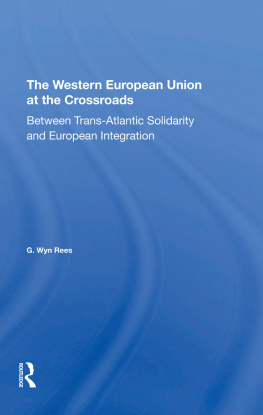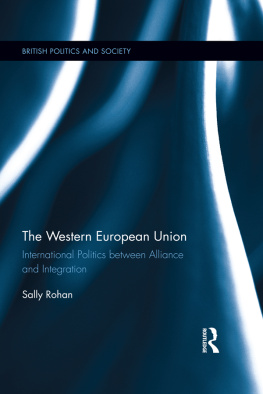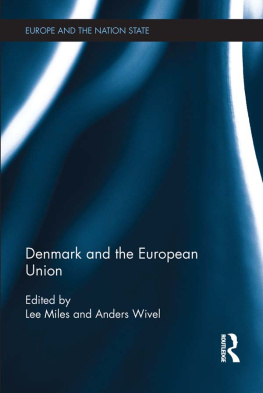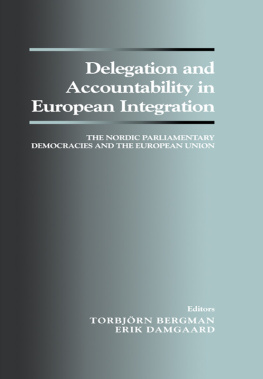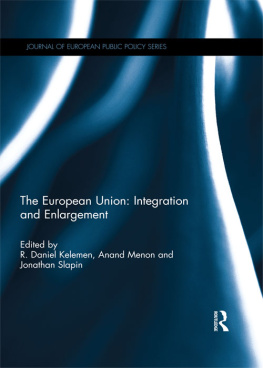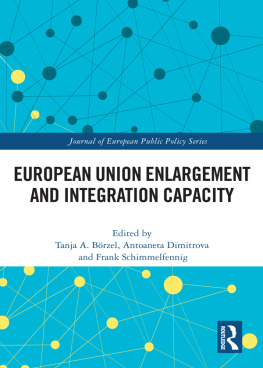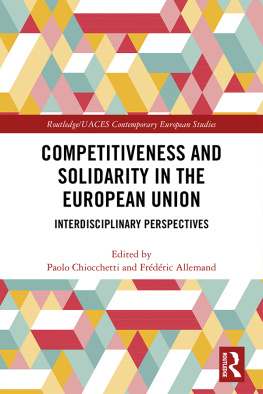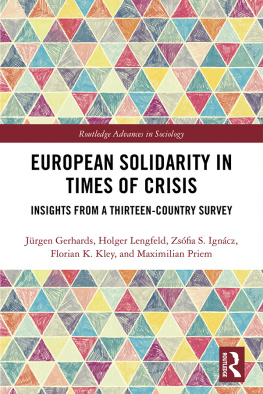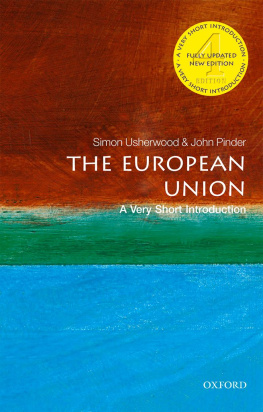The Western European Union at the Crossroads
The Western European Union at the Crossroads
Between Trans-Atlantic Solidarity and European Integration
G. Wyn Rees
First published 1998 by Westview Press
Published 2019 by Routledge
52 Vanderbilt Avenue, New York, NY 10017
2 Park Square, Milton Park, Abingdon, Oxon OX14 4RN
Routledge is an imprint of the Taylor & Francis Group, an informa business
Copyright 1998 by Taylor & Francis
All rights reserved. No part of this book may be reprinted or reproduced or utilised in any form or by any electronic, mechanical, or other means, now known or hereafter invented, including photocopying and recording, or in any information storage or retrieval system, without permission in writing from the publishers.
Notice:
Product or corporate names may be trademarks or registered trademarks, and are used only for identification and explanation without intent to infringe.
A CIP catalog record for this book is available from the Library of Congress.
ISBN 13: 978-0-367-27375-0 (hbk)
I would like to acknowledge the financial assistance of a NATO Fellowship Grant which paid for much of the research for this book and for a grant from the Faculty of Social Sciences, University of Leicester which assisted with the publication costs.
I would like to express my thanks to Paul Cornish, Stuart Croft, Ian Manners, Jrg Mar, Sally Rohan, Mathew Uttley and John Young who read parts of this manuscript and made helpful comments. I am also indebted to Thomas Thellersen and Richard Guthrie for work in preparing the manuscript.
This book is dedicated to my wife Susan with thanks for her love and patience.
G. W. R.
University of Leicester
To publish a book in 1998 about the Western European Union (WEU) is a particularly appropriate moment for it is the fiftieth anniversary of the founding of the organisation. It is also a short time after the Amsterdam European Council (June 1997), which sought to determine the WEU's institutional position for the foreseeable future. The WEU has always been a curious structure in Europe's security architecture. On the one hand, it has represented an autonomous European defence actor, based upon a treaty guarantee amongst its members. On the other, it has acted as a grouping of European states within the North Atlantic Treaty Organisation (NATO). As a result of its dual identity, the WEU has performed a variety of roles over the years. It has assisted in preserving the security of the continent, it has helped to smooth relations between the United States and its European allies and it has resolved tensions within Europe.
Whilst the focus of this book is on the period after 1990, it is necessary in the first two chapters to elucidate the background of the WEU. Although these chapters do not seek to be historically exhaustive, they explain the genesis of its multi-functional nature and the tasks for which it was prepared. The Cold War period determined the initial development of the organisation and this was to prove highly influential on its post-Cold War character. Despite the fact that the WEU had faded into relative obscurity by the middle of the 1970s, its members chose to revitalise the organisation in 1984, demonstrating that they believed it had a useful function to perform.
In 1990, amidst a transformed security environment, the WEU was suddenly under the international spotlight. The certainties of the Cold War were over, the Soviet Union was in retreat, Germany was unified and there were doubts about the continuing presence of the United States in Europe. The WEU was at a crossroads. The organisation had to choose between two roles: its traditional function of promoting Atlantic solidarity and the new-found opportunity of becoming a key participant in the process of European integration. In the past, integration had never extended into the realm of defence but after 1990 there were ambitions to develop a meaningful defence identity in Europe and the WEU was identified as the vehicle to carry this forward.
In order to understand the development of the WEU after 1990, this book contends that two lines of enquiry must be pursued. Firstly, the WEU must be analysed in relation to its two partner and larger organisations on the continent: the European Community (later the European Union) and NATO. The extent to which the Atlantic Alliance was capable of transforming itself to the new demands of the security situation was a central issue in determining the role of the WEU. Conversely, the time was seen to be propitious to create a foreign and security policy within the European Community and grant it a competence in defence; all of which would add coherence to the European construction project. The core of the debate was about whether the WEU would develop an independent defence identity amongst the west European states that would become submerged within the EC/EU.
The second line of enquiry focuses upon the parts played in this debate by Britain, France and Germany. Although there were ten states within the WEU and a collection of other countries enjoying membership in NATO and the EC, these three were the most powerful and influential European states in foreign and defence matters. As such, they held the key to the realisation of a defence identity on the continent. Each brought different post-war experiences to the issue but unless all were united in seeking the same objective, it was doubtful whether such a goal could be achieved.
Therefore, this book seeks to trace out three interconnected strands Firstly, what functions were historically fulfilled by the Western European Union and how important had these become by the end of the Cold War? Secondly, did the WEU as the embodiment of a European defence identity present a realistic alternative to the trans-Atlantic security framework of NATO in the post-Cold War period? Thirdly, to what extent were the three main west European states committed to realising a security and defence identity within the European Community/European Union?
The History of the WEU
It can sometimes be tempting to look back on the security arrangements that were constructed in western Europe during the Cold War and imagine that they were pre-determined. Because the North Atlantic Treaty Organisation came to dominate security politics and proved to be such a durable structure, one can be forgiven for assuming that this was somehow written in stone. It may be all too easy to forget the complexity of the post-war period, the intensity of the fears for the security of the continent and the search to find frameworks that could guarantee stability.
How security was to be achieved was far from clear to decision-makers at the time. Two fundamental sets of choices were apparent. The first was the balance that was to be struck between the Europeans providing for their own defence as compared to reliance upon the United States. Although it was not clear what role the US would seek to play in the security of the continent, the Europeans had to decide how closely to align with their North American ally. The WEU came to represent an expression of a European identity in defence and whilst cooperation with the US offered to fulfil vital objectives, it was recognised that European interests could be at risk of being submerged in a trans-Atlantic structure
The other major choice in defence was over the extent of the integration that would be undertaken by the European states. Defence integration offered a means of binding the states together in the face of a common adversary. It also offered a way of overcoming the fear of nationalistic rivalries and conflicts between the leading European countries. Yet integration was a major step to take so soon after the end of World War Two and it impacted on the core issue of national sovereignty; the ability of a country to defend itself. The question of how far to pursue integration was to prove a consistent thread running through the debate on a European defence identity.


